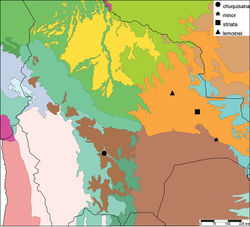Spixia minor
| Notice: | This page is derived from the original publication listed below, whose author(s) should always be credited. Further contributors may edit and improve the content of this page and, consequently, need to be credited as well (see page history). Any assessment of factual correctness requires a careful review of the original article as well as of subsequent contributions.
If you are uncertain whether your planned contribution is correct or not, we suggest that you use the associated discussion page instead of editing the page directly. This page should be cited as follows (rationale):
Citation formats to copy and paste
BibTeX: @article{Breure2016ZooKeys, RIS/ Endnote: TY - JOUR Wikipedia/ Citizendium: <ref name="Breure2016ZooKeys">{{Citation See also the citation download page at the journal. |
Ordo: Stylommatophora
Familia: Odontostomidae
Genus: Spixia
Name
Spixia minor (d’Orbigny, 1837) – Wikispecies link – Pensoft Profile
- Helix spixii var. minor d’Orbigny 1835[1]: 21. Nomen nudum.
- Pupa spixii var. β minor
d’Orbigny 1837 [1834–1847]: pl. 41bis fig. 11; d’Orbigny 1838 [1834–1847]: 320; Breure and Ablett 2012[2]: 26, figs 21A–F, 21i.
- Spixia minor; Cuezzo et al. 2013[3]: 178 (references, synonymy).
Type locality
[Bolivia] “province de Chiquitos, entre Santo-Corazon et San-Juan”; see Breure 1973[4]: 123.
Type material
NHMUK 1854.12.4.231, lectotype (Breure and Ablett 2012[2]), and NHMUK 1854.12.4.231 (7), paralectotypes.
Diagnosis
Shell slender and elongate, rather thin, broadly perforate, grayish-tawny coloured, sculptured with growth striae and a faint indication of spiral lines, suture abruptly ascending behind the lip, aperture oblique-ovate, with five teeth (small suprapalatal lamella, large palatal lamella, small basal lamella, prominent columellar lamella entering the aperture, large but relatively thin parietal lamella), peristome thickened, expanded.
Dimensions
Shell height 29.2, diameter 7.46 mm.
Distribution
Bolivia, Dept. Santa Cruz, between San Juan de Chiquitos and Ruinas de Santo Corazón.
Ecoregion
Dry Chaco [NT0210].
Remarks
Breure and Ablett (2012)[2] clarified the confusion about d’Orbigny’s varietal names for Pupa spixii by selecting lectotypes for each variety and giving minor specific status; the expert opinion of Cuezzo et al. (2013)[3] is here adopted for the current systematic position.
Taxon Treatment
- Breure, A; Avila, V; 2016: Synopsis of Central Andean Orthalicoid land snails (Gastropoda, Stylommatophora), excluding Bulimulidae ZooKeys, (588): 1-199. doi
Images
|
Other References
- ↑ d’Orbigny A (1835) Synopsis terrestrium et fluviatilium molluscorum, in suo per Americam meriodionalem itinere. Magasin de Zoologie 5(61): 1–44.
- ↑ 2.0 2.1 2.2 Breure A, Ablett J (2012) Annotated type catalogue of the Bothriembryontidae and Odontostomidae (Mollusca, Gastropoda, Orthalicoidea) in the Natural History Museum, London. ZooKeys 182: 1–70. doi: 10.3897/zookeys.182.2720
- ↑ 3.0 3.1 Cuezzo M, Miranda M, Ovando X (2013) Species catalogue of Orthalicoidea in Argentina (Gastropoda: Stylommatophora). Malacologia 56: 135–191. doi: 10.4002/040.056.0210
- ↑ Breure A (1973) Index to the neotropical land Mollusca described by Alcide d’Orbigny, with notes on the localities of the mainland species. Basteria 37: 113–135.

